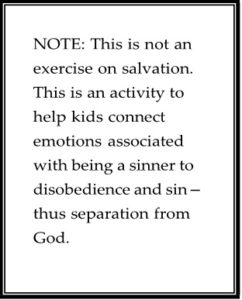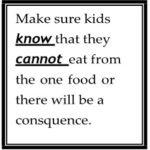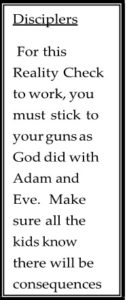For a downloadable/printable copy click Object Lessons- Yes or No?
Children are concrete thinkers – they require substance (sight, sound, touch, smell, and emotions) to learn. Children need to experience a concept for them to understand it.
What is an object lesson?
It is when you use an object, such as a Tootsie Pop, to describe an abstract spiritual concept- such as a sinner’s hardened heart. The adult is instructed to tell the kids that this candy reminds him how a person can have a relationship with Jesus.
The adult tells the kids that the center of the candy is soft, like a person’s heart. The adult explains that the Bible talks about having a hard heart. Our hearts become hard due to sin. Every time a person sins another layer of hard stuff surrounds the heart. Then, to make it worse, people refuse to admit they are sinners. Instead, they cover their sin with pride, denial, even doing things that make them look good. That is like the wrapper covering the candy.
When he repents (adult removes wrapper), the Holy Spirit can complete His work. The Holy Spirit licks past all the hard stuff covering the person’s heart (take a few licks) and gives him the gift of life that comes from Knowing Jesus as Savior.
Remember, children are concrete thinkers – they require substance (sight, sound, touch, smell, and emotions) to learn. Children need to experience a concept for them to understand it.
The Tootsie Pop is a concrete object; therefore, a child can understand it is hard on the outside and it is soft on the inside because they experience it. However, having the Tootsie Pop compared to the Biblical abstract symbol of a hardened heart is impossible for a child to understand. The hardened heart spoken of in the Bible does not mean that a person’s physical heart actually hardens; it is a metaphor.
A concrete thinking child is most apt to think of his physical heart instead of the heart as a metaphor. So now the child is thinking that with every sin his physical heart is going to become harder and harder. What does the child think the “hard stuff” is that surrounds his heart due to sin? Is it black like the Tootsie Pop? Does the Holy Spirit actually lick his heart? What is repentance — how do I take the candy wrapper off my heart?
An excerpt from A Theology of Children’s Ministry, by Dr. Larry Richards:
“Cognitive research has shown that children do not think in terms of abstract verbal concepts
that are learned as concepts and then applied to situations.
Instead children interact with their environment and from situations construct an understanding
that then guides their responses. This response to situations is intuitive in nature: that is,
the rational processes by which responses have been arrived at cannot be explained by children.
But the responses of children are adaptive.
Despite the fact that they cannot deal with cause and effect-
that they do not think in terms of series of events linked through
past and present into the future- children still do get along.
And their understanding of life and how to respond does develop.”
Consider the following:
Elsa, a kindergartner, and her Mom went to visit Grammy. Upon entering the house Mom said, “Elsa, tell Grammy what the pump is in your body.”
Elsa replied, “My heart.”
“Elsa, tell Grammy what makes you breathe.” Mom prodded “My lungs,” Elsa proudly replied.
Grammy quickly asked, “Elsa what does it mean to breathe?” “I don’t know,” came the hesitant answer
Not to be outdone, Mom told Elsa to show Grammy what it meant to breathe. With that Elsa took two huge intakes of breath. To put into words what the word “breathe” meant was too abstract. But Elsa did know what it meant to breathe because she had experienced breathing and thus had internalized the concept. The abstract concept “breathe” had become concrete to Elsa.
As a child matures he gains more and more intuitive understanding of abstract concepts because he has had more and more experiences in life. Thus a second grader is going to be able to explain more than a 4 year old and a 7th grader is going to explain more than the second grader.
One of the few passages in the Bible which instructs adults how to teach children is Deuteronomy 6: 4-9. It is through living, through experiencing the realities of life, along with observing others model what it means to love the Lord God with all their heart, soul and might that a child comes to understand the abstract truths of the Bible.
Children grow in their understanding of abstract concepts not because they are able to mentally reason the concept but because they have an intuitive understanding due to the reality of experience.
Jean Piaget, who laid out the stages of cognitive development, believed that full maturation had occurred by the time an individual was 16. Today we know this is not true. Previously they had only been able to study the brains of dead teenagers; today through the use of MRIs they are able to study living teenage brains. They have discovered that the brain of a teen is not yet fully formed.
The frontal lobe is often called the CEO, or the executive of the brain. It’s involved in things like planning and strategizing and organizing, initiating attention and stopping and starting and shifting attention. It’s a part of the brain that most separates man from beast, if you will. That is the part of the brain that has changed most in our human evolution, and a part of the brain that allows us to conduct philosophy and to think about thinking and to think about our place in the universe. …
I think that [in the teen years, this] part of the brain that is helping organization, planning and strategizing is not done being built yet … [It’s] not that the teens are stupid or incapable of [things]. It’s sort of unfair to expect them to have adult levels of organizational skills or decision making before their brain is finished being built. …” Dr. Jay Giedd, National Institute of Mental Health to read full study http://www.pbs.org/wgbh/pages/frontline/shows/teenbrain/interviews/giedd.html
The bold in the above quote is mine. If the thinking part of the brain, the portion that helps us think and/or reason isn’t yet formed then why do we think that a second grader can reason how a Tootsie Pop compares to the hardened heart spoken of in the Bible?
It is possible for the child to understand what a hardened heart is if she experiences her own hardened heart through an activity which brings her “hardened heart” to the surface. You can also ask questions about her obedience over the past week and get her to relive a disobedient moment along with the feelings related to that moment of a hardened heart.
The concept is understood not because of cognitive reasoning but due to intuitive insight.
In debriefing children after presenting an Object Lesson, actually after any lesson, we must take this warning seriously.
“Those who guide the theological development of children need to know that children can learn the technical verbal symbols of theology and use all of the proper terms and still not be able to apply or define those terms to everyday life.” A Theology for Children, William L. Hendricks, pg 37
An Object Lesson requires the ability for cognitive understanding such as how a “Tootsie Pop relates to the spiritual symbol of a hardened heart.” We all too often place our adult perceptions in the words used by the children. They may repeat back to you using words that are way above their level of understanding — it does not mean those words mean the same to the child as they do to you.
The other problem with Object Lessons is that they often are not Biblically correct. The Holy Spirit licks our hearts? Really? The Holy Spirit is a spirit; does He even have a tongue?
All of the object lessons used to explain the Trinity (of which I’m aware) are actually heresies. Here is one of the more common that is used:
H20 (water) shows us the Trinity since H20 can be three things: solid (ice), liquid (running water), and vapor (steam). But the same H20 molecules cannot be all three at exactly the same time. H20 is a good illustration of modalism (a false teaching of the Trinity) where God is first the Father, then the Son, and then the Spirit, one at a time.
But the Bible teaches that God is Father, Son, and Holy Spirit all at the same time. Each Person lives eternally as God. Big Truths for Young Hearts, Bruce A Ware
It is vital that we teach children truth — that we work hard to not misrepresent who God is.
I would highly advise that Object Lessons not be used in the teaching of children in regard to Biblical truth. At the very least you may have given children a great fun time with little understanding of what you were trying to explain. At the worse you may be teaching them a Biblical untruth – such as that the Holy Spirit has a tongue and He licks your heart.
If we don’t use Object Lessons what can we use? Reality Lessons
I have used this tool for over 30 years and continue to be amazed at the ah-ha’s children have as they experience Biblical truth. I will never forget the gasp of a sixth grader after having experienced the Reality Lesson below and then in the midst of the Genesis 3 study she stopped the study with a cry, “I’m Eve.”
A REALITY LESSON IS WHEN:
- A NEED IS
- SENSES ARE
- EMOTIONS ARE
- EVERYTHING IS DIRECTED TOWARD THE GOAL OF ALLOWING THE CHILD TO EXPERIENCE A BIBLICAL TRUTH IN
MATERIALS Assorted foods (read below – your decision)
- Reality Check is a snack
- Disciplers determine how kids will be grouped for this snack depending on size of Children’s
- It will be more effective with more than one Trek Team participating
- Have first thru third graders together and fourth thru sixth graders together.
- Ask church members, who aren’t usually involved with children’s ministry if they would purchase, set up and serve the snack.
-
- What is served will depend on time of day
- Early morning might be donuts, cereal, milk, orange juice
- Close to lunch might be sandwich fixings, salads, potato chips
- What is served will depend on time of day
-
- Because you know your children think of what they like, what will be tempting to them.
- Either the Children’s Ministry Pastor/Director or a Discipler tells the kids that they can eat everything on the table except one item – the item they most like.
- It should also be something that is easy to grab with their fingers.
- Pray over the food then remind them that there is one important rule.
- If they break the rule the consequences will be great.
- They may eat anything on the table except this one dish.
- Disciplers are in another room or walking around doing something else, not paying attention to the kids.
- Have an adult(s) the kids don’t know, walk around the room, or sit at the table with the kids, trying to entice the kids to eat the forbidden food.
- The “serpent” (the unknown adult) should look like someone they would respect.
- Remember, the Bible tells us the enemy comes as an angel of light.
- Satan was the most beautiful angel; he did not appear to Adam and Eve as an evil being.
- Use the enticements that Satan used.
- The Disciplers just want it for themselves.
- Nothing is going to happen to you.
- They are just teasing you, fooling you.
- The “Serpent” should be aware of which kids follow her lead to eat the forbidden food.
- When everyone is finished eating have them gather in a circle on the floor.
- The “serpent” should stay in character throughout the debriefing.
DEBRIEFING
(In same grouping as REALITY CHECK was implemented)
1. Well it is now time for the rewards to be given out. Disciplers, did any of your kids eat from the forbidden food?
Disciplers mention the kids who were enticed. The “serpent” mentions the kids she saw. Be sure you know who is innocent and who is guilty.
2. O.K. I would like everyone who ate the forbidden food to come stand by me. 
Once they are all up by the facilitator, you send them into another room with the “serpent.” Make sure all those who “sinned” come.
3. All who ate of the forbidden food must now go off with (name of individual playing the “serpent” ). You who ate of the forbidden food will not receive the reward that everyone else will receive. Everyone else is going to receive 100 Bucks. When the store is open today, you do not get to go to the store.
The “serpent” takes the kids to another room where they have to just sit for awhile. It should be a boring, restless time; no talking, no interacting; just sitting. The disciplers give all the other kids 100 Bucks each.
For a downloadable/printable copy click Object Lessons- Yes or No?
Click If this has blessed you, even a dollar helps, gift is appreciated.


